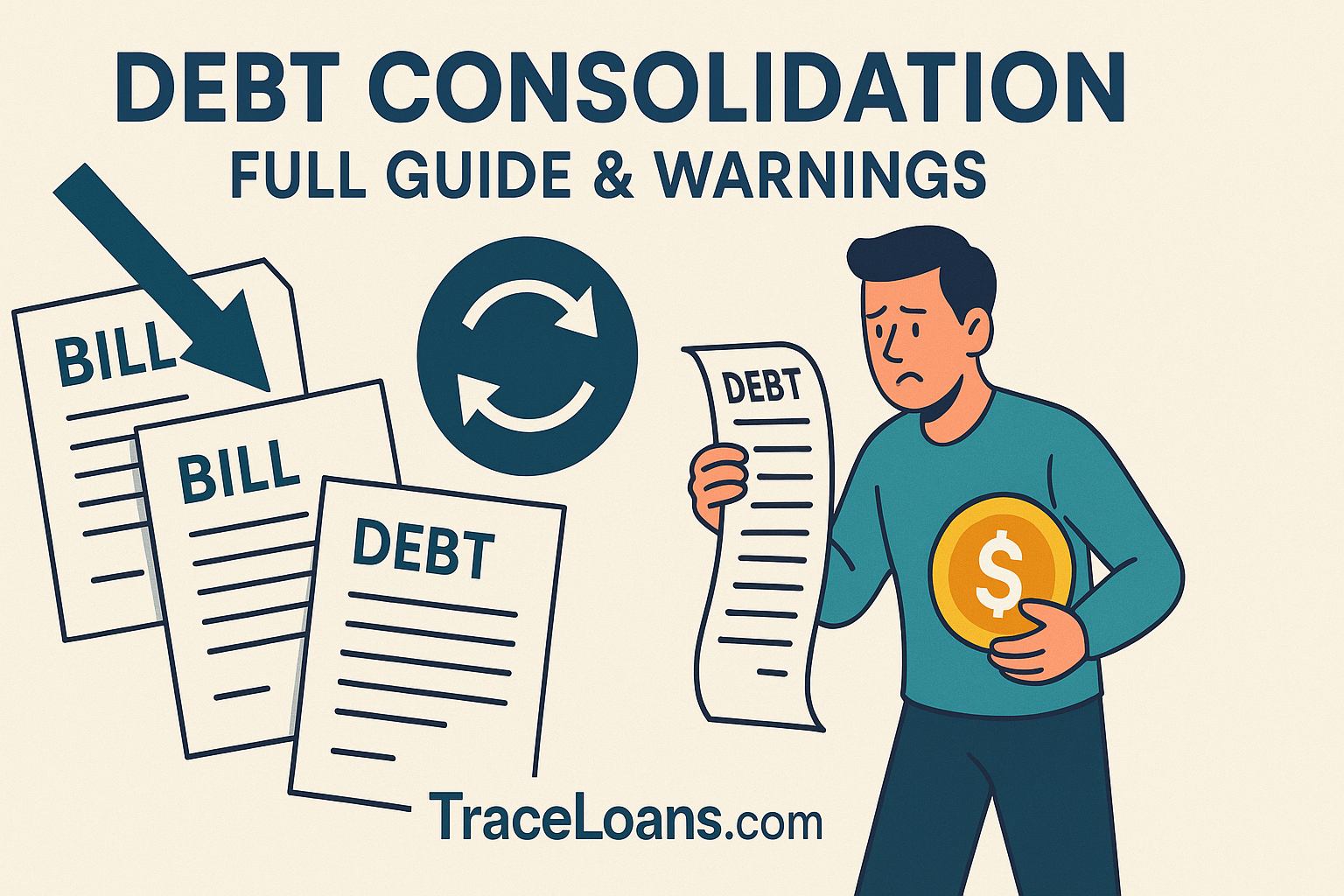Struggling with multiple monthly payments across credit cards, personal loans, and other debts? You’re not alone. Millions of Americans juggle various debt obligations, often paying high interest rates and feeling overwhelmed by different due dates and payment amounts.
Debt consolidation offers a potential solution by combining multiple debts into a single loan with one monthly payment. This financial strategy can simplify your payment schedule and potentially reduce your overall interest costs. However, it’s not always the right choice for everyone.
TraceLoans.com provides educational resources about debt consolidation options, but understanding the full picture—including potential risks and alternatives—is crucial before making any decisions. This guide will walk you through everything you need to know about debt consolidation, helping you determine if it aligns with your financial goals.
What Is Debt Consolidation?
Debt consolidation involves taking out a new loan to pay off multiple existing debts. Instead of managing several payments with different interest rates and due dates, you’ll have one monthly payment to a single lender.
The most common types of debt consolidation include:
Personal Loans for Debt Consolidation
These unsecured loans typically offer fixed interest rates and repayment terms between 2-7 years. You receive a lump sum to pay off existing debts, then make monthly payments on the new loan.
Balance Transfer Credit Cards
These cards offer promotional 0% APR periods (usually 12-21 months) on transferred balances. You move existing credit card debt to the new card and ideally pay it off before the promotional rate expires.
Home Equity Loans or Lines of Credit
These secured loans use your home as collateral, often offering lower interest rates but putting your property at risk if you can’t repay.
Debt Management Plans
Working with a credit counseling agency, these plans negotiate with creditors to reduce interest rates and create a structured repayment schedule.
How TraceLoans.com Approaches Debt Consolidation
Based on their educational content, TraceLoans.com emphasizes the importance of understanding your complete financial picture before pursuing debt consolidation. Their resources suggest evaluating:
- Your current debt-to-income ratio
- Credit score and how it affects loan terms
- Total interest costs over the life of different loan options
- Your ability to avoid accumulating new debt after consolidation
The platform appears to focus on education rather than direct lending, providing guides to help borrowers make informed decisions about various loan products, including those used for debt consolidation.
Benefits of Debt Consolidation
When used appropriately, debt consolidation can offer several advantages:
Simplified Payments
Managing one monthly payment instead of multiple debts reduces the risk of missed payments and makes budgeting easier.
Potential Interest Savings
If you qualify for a lower interest rate than your current debts, consolidation can reduce total interest costs over time.
Fixed Repayment Schedule
Personal loans for debt consolidation typically offer fixed rates and terms, providing predictable monthly payments and a clear payoff date.
Credit Score Improvements
Successful debt consolidation can improve your credit utilization ratio and payment history, potentially boosting your credit score over time.
Reduced Financial Stress
Streamlining multiple debts into one payment can provide psychological relief and make debt management feel more achievable.
Serious Warnings and Risks to Consider
Despite its benefits, debt consolidation carries significant risks that borrowers must understand:
You Haven’t Addressed the Root Problem
Consolidation doesn’t eliminate debt—it reorganizes it. Without changing spending habits, many people accumulate new debt on top of their consolidation loan, worsening their financial situation.
Potentially Higher Total Costs
While monthly payments might decrease, extending repayment terms often increases total interest paid over the loan’s lifetime.
Qualification Challenges
Borrowers with poor credit may not qualify for favorable rates, making consolidation less beneficial or even counterproductive.
Secured Loan Risks
Using home equity for debt consolidation puts your property at risk. Defaulting could result in foreclosure.
Fee Considerations
Balance transfer fees, origination fees, and other costs can offset potential savings from lower interest rates.
Temporary Credit Score Impact
Applying for new credit and closing old accounts can temporarily lower your credit score.
Red Flags: When to Avoid Debt Consolidation
Debt consolidation isn’t suitable for everyone. Avoid this strategy if:
- You haven’t addressed underlying spending problems
- The new loan has a higher interest rate than your current average
- You’re considering using retirement funds to pay off debt
- You’re already behind on payments and facing collection actions
- You have insufficient income to make consistent payments
- You’re considering bankruptcy as an alternative
Step-by-Step Guide to Debt Consolidation
If debt consolidation seems appropriate for your situation, follow these steps:
1. Calculate Your Total Debt
List all debts including balances, interest rates, minimum payments, and due dates. This gives you a clear starting point for comparison.
2. Check Your Credit Score
Your credit score determines available loan options and interest rates. Scores above 670 typically qualify for better terms.
3. Research Loan Options
Compare personal loans, balance transfer cards, and other consolidation methods. Look beyond monthly payments to total costs and terms.
4. Get Pre-qualified
Many lenders offer prequalification with soft credit pulls that don’t affect your credit score. This helps you compare real offers.
5. Choose the Best Option
Select the loan with the lowest total cost and terms that fit your budget and timeline.
6. Apply and Use Funds Properly
Once approved, use loan proceeds exclusively to pay off designated debts. Don’t be tempted to use extra funds for other purposes.
7. Create a Repayment Plan
Set up automatic payments and create a budget that prevents new debt accumulation.
Alternatives to Debt Consolidation
Before pursuing consolidation, consider these alternatives:
Debt Avalanche Method
Pay minimums on all debts while putting extra money toward the highest-interest debt first.
Debt Snowball Method
Pay minimums on all debts while focusing extra payments on the smallest balance first.
Credit Counseling
Nonprofit credit counseling agencies can help create debt management plans and negotiate with creditors.
Debt Settlement
Though risky and damaging to credit, debt settlement involves negotiating to pay less than owed.
Bankruptcy
As a last resort, bankruptcy can provide debt relief but has long-lasting credit consequences.
Is TraceLoans.com Debt Consolidation Right for You?
While TraceLoans.com provides educational resources about debt consolidation, the decision ultimately depends on your specific financial situation. Consider consolidation if you:
- Have good to excellent credit (670+ credit score)
- Can qualify for a lower interest rate than current debts
- Have steady income to support consistent payments
- Are committed to avoiding new debt accumulation
- Want to simplify your payment schedule
Avoid consolidation if you haven’t addressed spending habits, can’t qualify for favorable terms, or are considering more drastic debt relief options.
Taking Control of Your Financial Future
Debt consolidation through platforms like TraceLoans.com can be a valuable tool for managing multiple debts, but it’s not a magic solution. Success requires honest assessment of your financial habits, careful comparison of loan options, and commitment to avoiding future debt accumulation.
Before making any decisions, consider speaking with a financial advisor or credit counselor who can provide personalized guidance based on your specific situation. Remember that the goal isn’t just to consolidate debt—it’s to create a sustainable path toward financial freedom.
Start by calculating your total debt and checking your credit score. Then research your options thoroughly, keeping in mind both the potential benefits and serious risks involved. With careful planning and disciplined execution, debt consolidation might help you regain control of your finances and work toward a debt-free future.

















